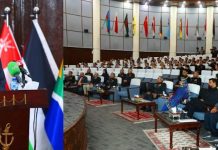Anjum Nisar says frequent upward policy rate, fluctuations in rupee posing further challenges
ISLAMABAD, JUL 9 /DNA/ – The ever-increasing cost of production in the country is the real threat to both large-scale manufacturing (LSM) and small-scale businesses (SMEs), as frequent upward revisions in policy rate and continuous fluctuations in rupee against dollar are posing further challenges in spite of optimism about foreign reserves, reaching over $14 billion by the end of August 2023.
This was stated by FPCCI former president and Businessmen Panel (BMP) Chairman Mian Anjum Nisar, observing that the aggressive economic measures, high borrowing rates, inflation, oppressive taxation and unstable currency have been negatively affecting running businesses, many of which have closed their operations, while the remaining are struggling for survival.
With a view to deal with fiscal challenges Mian Anjum asked the government to work on the three-way strategy by implementing short-term goals that will help to keep generating resources for smooth fiscal operations, medium-term goals where the government should focus on financial inclusion, documenting the economy by designing a system where all businesses can be registered and properly document their income including collection of sales tax, initiating the process of privatization as well as improving governance by introducing reforms in each sector. As a long-term goal, the country must focus on improving its human capital, and revamping IT sectors by extending facilitations and providing all the requisite supports. In the same way, we also need to work on designing a comprehensive and proactive strategy to tackle challenges related to strengthening border security and implementing effective and comprehensive Anti-Money Laundering and Terrorist Financing measures holding accountable and taking to task all those who are involved in illegitimate activities, undermining both our economy and national interests.
The BMP Chief said that the government does not have any pragmatic plan to address this liability, apart from asking for more loans to repay existing debt. Likewise, the target for current financial year’s exports is too low to meet the country’s revenue.
The conventional approach of focusing solely on improving exports while pursuing a passive and imprudent foreign policy towards neighboring countries, poses a significant challenge in meeting export targets. Despite strained relations, the United States remains the largest importer of Pakistani products. Still, there are no efforts to tap into the vast markets of neighboring countries or negotiate trade agreements with them. Even though Pakistan and China enjoy close relations yet the volume of exports to China is significantly lower compared to USA. Furthermore, the existing Pakistan China Free Trade Agreement (PCFTA) tends to benefit Chinese-origin corporations more than Pakistani businesses, giving them greater market access at the expense of Pakistani products.
Mian Anjum Nisar said that the government is neglecting two important factors, namely, Information Technology and export of human capital that together can contribute towards generating foreign exchange and mobilizing revenue. It is essential to concentrate on nurturing a skilled workforce and assisting them in securing international employment opportunities. This approach would have a positive impact on our foreign policy and help in building foreign exchange reserves. Given the era of the fourth industrial revolution, Pakistan should prioritize facilitating IT businesses, enabling their access to international markets. By doing so, we can assert our fair share in the international market for IT-related exports.
It is good that State Bank of Pakistan has outlined the central bank’s vision for the future, with a strong focus on price stability. According to him, SBP has set a medium-term inflation target of 5% to 7% and is determined to achieve this goal within the next two years. In addition, efforts are being made to enhance efficiency, effectiveness, and stability in the financial sector. To this end, ‘Strategic Plan SBP Vision 2028’ has been developed, aiming to improve centre bank’s credibility, independence, and inclusiveness.
The SBP further emphasised the need to expand access to financial services for a larger segment of population and revealed that under Vision 2028, efforts would be made to bring more people into formal financial system. Furthermore, SBP is planning to connect Pakistan’s remittance system with Arab Monetary Funds (AMF) Buna, a cross-border payment system. This integration is expected to significantly improve speed and reduce cost of remittance transactions.
Although above measures would improve our financial system, yet the government should reconsider its approach to expanding the tax base, as it currently burdens existing taxpayers instead of including new sectors. The recent decision to collect Rs215 billion by taxing salaried individuals is a regressive approach. It would adversely affect middle-income earners. However, no initiatives are being taken to bring traders into the tax net, nor is the government showing interest in establishing a system that can accurately track their actual incomes and combat the problem of fake invoicing.
The government’s passive approach in addressing these significant issues not only encourages trade-based money laundering (TBML) but also weakens border controls, enabling criminal syndicates to smuggle various products, including currency, without any fear of being arrested. This rampant smuggling is depleting our resources, and the burden of this incompetence falls solely on the shoulders of diligent taxpayers.












